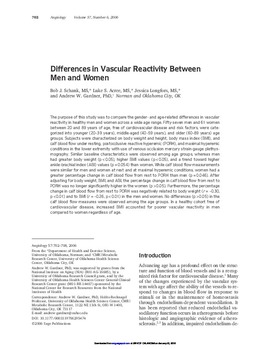| dc.identifier.citation | Schank, B. J., Acree, L. S., Longfors, J., & Gardner, A. W. (2007). Differences in Vascular Reactivity Between Men and Women. Angiology, 57(6), 702-708. doi: 10.1177/0003319706295474 | en_US |
| dc.description.abstract | The purpose of this study was to compare the gender and age-related differences in vascular reactivity in healthy men and women across a wide age range. Fifty-seven men and 61 women between 20 and 89 years of age, free of cardiovascular disease and risk factors, were categorized into younger (20-39 years), middle-aged (40-59 years), and older (60-89 years) age groups. Subjects were characterized on body weight and height, body mass index (BMI), and calf blood flow under resting, postocclusive reactive hyperemic (PORH), and maximal hyperemic conditions in the lower extremity with use of venous occlusion mercury strain-gauge plethysmography. Similar baseline characteristics were observed among age groups, whereas men had greater body weight (p<0.05), higher BMI values (p<0.05), and a trend toward higher ankle-brachial index (ABI) values (p=0.054) than women. While calf blood flow measurements were similar for men and women at rest and at maximal hyperemic conditions, women had a greater percentage change in calf blood flow from rest to PORH than men (p=0.046). After adjusting for body weight, BMI, and ABI, the percentage change in calf blood flow from rest to PORH was no longer significantly higher in the women (p>0.05). Furthermore, the percentage change in calf blood flow from rest to PORH was negatively related to body weight (r = -0.30, p<0.01) and to BMI (r = -0.26, p<0.01) in the men and women. No differences (p>0.05) in the calf blood flow measures were observed among the age groups. In a healthy cohort free of cardiovascular disease, increased BMI accounted for poorer vascular reactivity in men compared to women regardless of age. | en_US |
